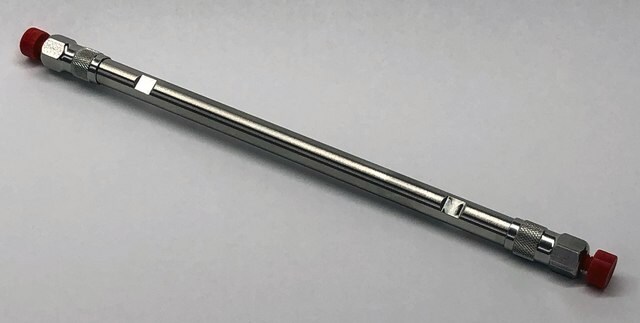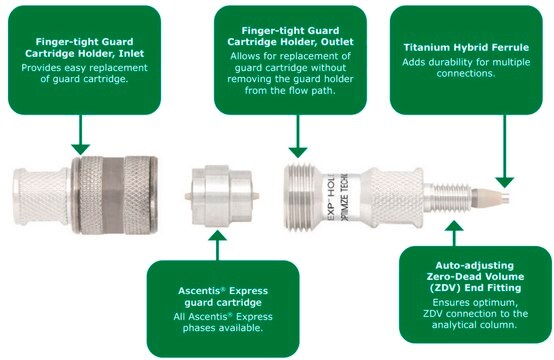581616-U
Ascentis® Phenyl (5 µm) HPLC Columns
L × I.D. 15 cm × 4.6 mm, HPLC Column
Synonym(s):
Phenyl HPLC Column
About This Item
Recommended Products
Product Name
Ascentis® Phenyl HPLC Column, 5 μm particle size, L × I.D. 15 cm × 4.6 mm
material
stainless steel column
Quality Level
Agency
suitable for USP L11
product line
Ascentis®
feature
endcapped
manufacturer/tradename
Ascentis®
packaging
1 ea of
extent of labeling
19% Carbon loading
parameter
≤70 °C temp. range
400 bar pressure (5801 psi)
technique(s)
HPLC: suitable
LC/MS: suitable
L × I.D.
15 cm × 4.6 mm
surface area
450 m2/g
surface coverage
5.2 μmol/m2
impurities
<5 ppm metals
matrix
fully porous particle
silica gel high purity, spherical
matrix active group
phenyl phase
particle size
5 μm
pore size
100 Å
operating pH range
2-8
application(s)
food and beverages
separation technique
reversed phase
Looking for similar products? Visit Product Comparison Guide
Related Categories
General description
The Ascentis Phenyl provides superior separations in reversed-phase mode including 100% aqueous conditions. It may also be used in HILIC/ANP (aqueous normal phase) mode and shows low UV/MS bleed for gradient applications.
Application
- A Different Perspective on the Characterization of a New Degradation Product of Flibanserin With HPLC-DAD-ESI-IT-TOF-MSn and Its Pharmaceutical Formulation Analysis With Inter-Laboratory Comparison: This study highlights the advanced chromatographic techniques used to characterize pharmaceutical compounds, demonstrating the importance of accurate and detailed analysis in pharmaceutical research. The use of the Ascentis® Phenyl HPLC column facilitates high-resolution separations, essential for identifying degradation products in complex mixtures (Geven et al., 2023).
- HPLC with Spectrophotometric or Mass Spectrometric Detection for Quantifying Very-Long Chain Fatty Acids in Human Plasma and Its Association with Cardiac Risk Factors: This paper discusses the role of high-performance liquid chromatography (HPLC) in clinical settings, particularly for the assessment of biomarkers related to heart disease. Techniques involving the Ascentis® Phenyl HPLC column are employed to achieve precise and reliable quantification of fatty acids, critical for clinical diagnostics (Shrestha et al., 2021).
- A Fully Automated and Fast Method Using Direct Sample Injection Combined with Fused-Core Column On-Line SPE-HPLC for Determination of Ochratoxin A and Citrinin in Lager Beers: This study introduces an automated method for toxin analysis in beverages, utilizing the Ascentis® Phenyl HPLC column. The approach enhances sensitivity and throughput, showcasing the column′s efficacy in food safety applications (Lhotská et al., 2016).
- A Study of Retention Characteristics and Quality Control of Nutraceuticals Containing Resveratrol and Polydatin Using Fused-Core Column Chromatography: The research focuses on nutraceuticals, where the Ascentis® Phenyl HPLC column′s selectivity plays a pivotal role in segregating and analyzing health-promoting compounds, thereby ensuring product quality and compliance with industry standards (Fibigr et al., 2016).
- An On-Line SPE-HPLC Method for Effective Sample Preconcentration and Determination of Fenoxycarb and Cis, Trans-Permethrin in Surface Waters: This publication illustrates the application of the Ascentis® Phenyl HPLC column in environmental analysis, particularly for the sensitive detection of pesticides in water bodies. The column′s capabilities help in tracing low-level contaminants, critical for environmental monitoring and protection (Šatínský et al., 2015).
Features and Benefits
- 100% Aqueous Compatible
- ANP/HILIC and reversed-phase
- Low UV/MS bleed for gradient applications
- Alternate selectivity
Legal Information
guard cartridge
related product
Choose from one of the most recent versions:
Already Own This Product?
Find documentation for the products that you have recently purchased in the Document Library.
Global Trade Item Number
| SKU | GTIN |
|---|---|
| 581616-U | 4061838549617 |
Our team of scientists has experience in all areas of research including Life Science, Material Science, Chemical Synthesis, Chromatography, Analytical and many others.
Contact Technical Service




